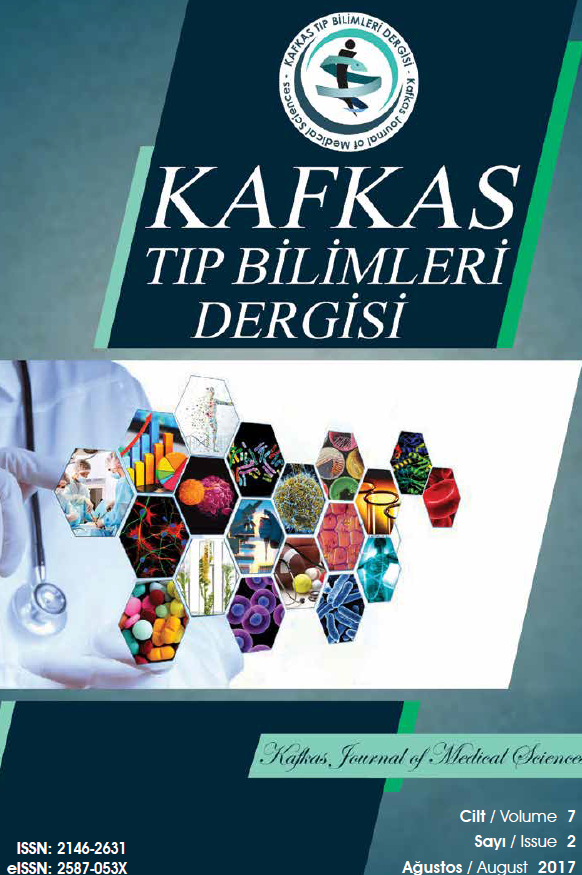Seldinger Yöntemi ile Gerçekleștirilen Perkütan Nefrostomi Deneyimlerimiz
obstruksiyon, nefrostomi, Seldinger tekniği
Our Experiences with Percutan Nephrostomy by Seldinger Technique
obstruction, nephrostomy, Seldinger technique,
___
- 1. Goodwin, W. E., W. C. Casey, and W. Woolf. Percutaneous trocar (needle) nephrostomy in hydronephrosis. J Am Med Assoc 1955 157(11): p.891–4.
- 2. Seldinger, S. I., Catheter replacement of the needle in percutaneous arteriography; a new technique. Acta radiol 1953 39(5): p.368–76.
- 3. Hogan, M. J., B. D. Coley, V. R. Jayanthi, et al. Percutaneous Nephrostomy in Children and Adolescents: Outpatient Management 1. Radiology 2001 218(1): p.207–210.
- 4. Egilmez, H., I. Oztoprak, M. Atalar, et al. The place of computed tomography as a guidance modality in percutaneous nephrostomy: analysis of a 10-year single-center experience. Acta Radiol 2007 48(7): p.806–813.
- 5. Grabe M, B. -J. T., Botto H, Wullt B, Çek M, Naber KG. Guidelines on urological infections. Eur Ass Urol (EAU), 2011: p.33–39.
- 6. Wah, T., M. Weston, and H. Irving, Percutaneous nephrostomy insertion: outcome data from a propspective multi-operator study at a UK training centre. Clin radiol 2004 59(3): p.255–261.
- 7. Watson, R. A., M. Esposito, F. Richter, et al. Percutaneous nephrostomy as adjunct management in advanced upper urinary tract infection. Urology 1999 54(2): p.234–239.
- 8. Zegel, H., H. Pollack, M. Banner, et al. Percutaneous nephrostomy: comparison of sonographic and fluoroscopic guidance. Am J of Roentgen 1981 137(5): p.925–927.
- 9. Nielsen, O. S. and E. Grossmann. Ultrasonically guided percutaneous nephrostomy. Scand J Urol Nephrol 1990 24(3): p.219–21.
- 10. Sood, G., A. Sood, A. Jindal, et al. Ultrasound guided percutaneous nephrostomy for obstructive uropathy in benign and malignant diseases. Int braz j urol 2006 32(3): p.281–286.
- 11. Kehinde, E., C. Newland, T. Terry, et al. Percutaneous nephrostomies. British journal of urology 1993 71(6): p.664–666.
- 12. Ramchandani, P., J. F. Cardella, C. J. Grassi, et al. Quality improvement guidelines for percutaneous nephrostomy. J Vasc Interv Radiol 2001 12(11): p.1247–51.
- 13. Li, A. C. and S. P. Regalado. Emergent percutaneous nephrostomy for the diagnosis and management of pyonephrosis. in Seminars in interventional radiology 2012. Thieme Medical Publishers.
- 14. Patel, U., Percutaneous nephrostomy insertion: outcome data from a prospective multi-operator study at a UK training centre. Clin Radiol 2004 59(3): p.253–4.
- 15. Farrell, T. A. and M. E. Hicks, A review of radiologically guided percutaneous nephrostomies in 303 patients. J vasc and int radiol 1997 8(5): p.769–774.
- 16. Gupta, S., M. Gulati, K. U. Shankar, et al. Percutaneous nephrostomy with real-time sonographic guidance. Acta Radiol 1997 38(3): p.454–457.
- 17. Sacks, D., T. E. McClenny, J. F. Cardella, et al., Society of Interventional Radiology clinical practice guidelines. J vasc and int radiol 2003 14(9): p. S199-S202.
- 18. Dagli, M. and P. Ramchandani. Percutaneous nephrostomy: technical aspects and indications. in Seminars in interventional radiology 2011. © Thieme Medical Publishers.
- ISSN: 2146-2631
- Yayın Aralığı: Yılda 3 Sayı
- Başlangıç: 2011
- Yayıncı: Kafkas Üniversitesi
Seldinger Yöntemi ile Gerçekleștirilen Perkütan Nefrostomi Deneyimlerimiz
Mustafa Bilal HAMARAT, Alper KAFKASLI, Özgür YAZICI, Serkan ÖZCAN, Murat BAĞCIOĞLU, Murat TUNCER, Mehmet Kutlu DEMİRKOL, Oktay AKÇA
Aşı Reddine Genel Bir Bakış ve Literatürün Gözden Geçirilmesi
Kars Şehrindeki Yaşlı Nüfusta Görme Bozukluğu ve Körlüğün Yaygın Nedenleri
Yaran KOBAN, Mustafa KOÇ, Halil Hüseyin ÇAĞATAY
Pediatrik Hastalarda Uyguladığımız Anestezi ve Analjezi Yöntemleri
Semih BAŞKAN, Duygu KAYAR, Mehmet GAMLI, Eda MACİT, Dilşen ÖRNEK, Oya KILCI, Canan ÜN, Özgür ALDEMİR
Dokuz Maddelik Avrupa Kalp Yetmezliği Özbakım Ölçeği’nin Türkçe Geçerlilik ve Güvenilirliği
İbrahim RENCÜZOĞULLARI, Mehmet Necdet AKKUŞ
Hipertiroidilerde Reaksiyon Zamanının Oddball Paradigması ile Araştırılması
Nazan DOLU, Seval KELOĞLAN MÜSÜROĞLU, Leyla ŞAHİN, Kürşad ÜNLÜHİZARCI, Mustafa Tayfun TURAN
Venlafaksin Tedavisine Sülpirid Eklenmesi Sonrası Görülen Hiperprolaktinemi: Olgu Sunumu
İbrahim YAĞCI, Yasin TAŞDELEN, Yüksel KIVRAK
Bülent HUDDAM, Alper AZAK, Özgür DEMİRHAN, Nilüfer BAYRAKTAR, Volkan KARAKUŞ, Yelda DERE, Siren SEZER
